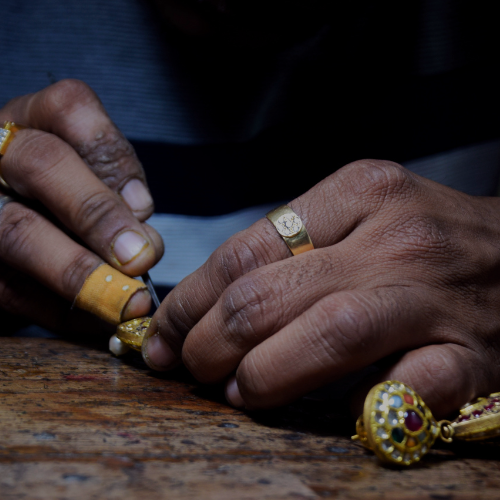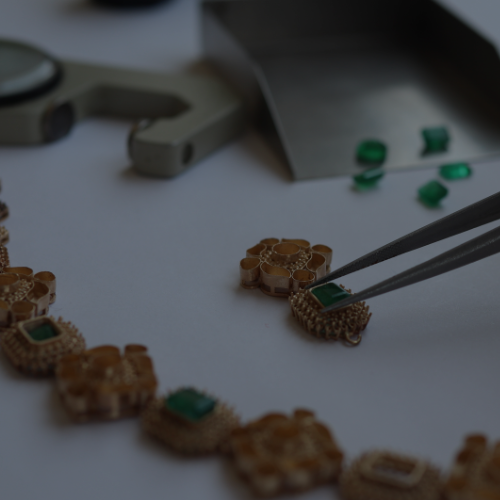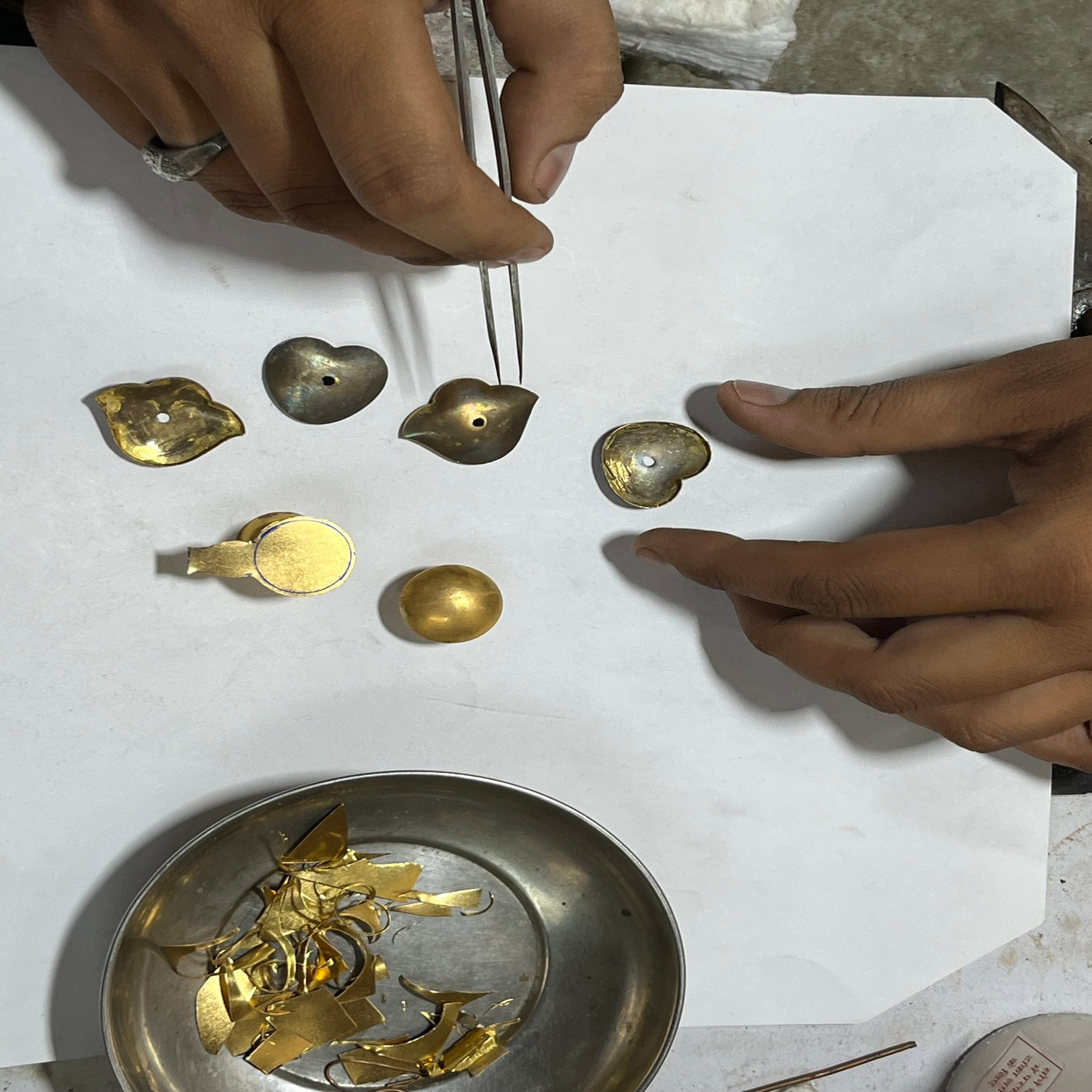Materials
14k Gold
14k gold contains 58.3% pure gold mixed with
other metals like copper, silver, or zinc for added durability and strength. It
is a popular choice for everyday jewelry due to its affordability, durability,
and resistance to tarnishing.
18k Gold
18k gold consists of 75% pure gold alloyed
with other metals like copper, silver, or palladium. It is known for its rich
color and durability. It is a luxurious option for fine jewelry, offering a
balance between purity and strength. 18k gold jewelry is valued for its
elegance and longevity. 18k gold jewelry is often used for engagement rings,
wedding bands, and high-end fashion pieces due to its premium quality and
exquisite appearance.
22k Gold
22k gold contains 91.7% pure gold mixed with
a smaller percentage of other metals, making it softer and more prone to
scratches compared to lower-karat gold. It is popular in traditional and
cultural jewelry, prized for its rich color and intrinsic value. 22k gold is
commonly used in intricate designs and craftsmanship. It is also cherished for
its detailing and heritage significance, often seen in traditional jewelry.
24k Gold
24k gold is pure gold without any alloying
metals, making it the most malleable and softest form of gold. It is not
commonly used for jewelry due to its susceptibility to damage.It is highly
prized for its purity and inherent value. 24k gold is often used for investment
purposes rather than everyday wear jewelry. While 24k gold jewelry is rare, it
is occasionally used for statement pieces or in regions where pure gold jewelry
is culturally significant. However, it requires extra care due to its softness
and susceptibility to bending or scratching.
Full Cut Diamond/Brilliant Cut Diamond
Full-cut diamonds, also known as
brilliant-cut diamonds, are characterized by their sparkle and brilliance. They
symbolize eternal love and commitment. Brilliant cuts have facets arranged to
maximize the brilliance of a diamond. It also has triangular and kite-shaped
facets that extend out from the center and reflect a prism of light. Perfect
for special occasions like weddings, anniversaries, or formal events. Best worn
as engagement rings, pendants, or earrings for a touch of timeless elegance.
Polki/Vilandi
Polki or Vilandi diamonds are uncut, raw
diamonds traditionally set in intricate designs. They reflect heritage and
cultural richness. Ideal for weddings, festivals, or traditional celebrations. Syndicate, Zimbabwe, and Khilwas
are the three types of polki. Of the three, Syndicate is better, followed by
Zimbabwean polki, which refers to diamonds from Zimbabwe in Africa. Khalwas are
typically those of low quality.
Rose Cut Diamond
Rose-cut diamonds feature a flat base and
triangular facets, resembling the petals of a rose. They evoke vintage charm
and romance. The
number of these facets can vary from as few as 3 up to as many as 24, which
terminate at the very top in a single apex. Suitable for both casual and formal
occasions, adding a touch of understated elegance. Rose-cut diamond rings or
earrings can complement everyday outfits or evening ensembles with equal grace.
Meenakari
Meenakari is the art of decorating metal
surfaces with vibrant enamel colors. It signifies tradition, craftsmanship, and
cultural heritage. An old
method of enameling or decorating metal surfaces with vibrant enamels derived
from a mixture of metal oxides and glass is called meenakari. Perfect
for traditional events, cultural gatherings, or festive occasions.
Basra Pearl
Basra pearls are among the rarest and most
sought-after pearls in the world. They are natural pearls found in the Persian
Gulf, particularly near the coast of Basra (now part of Iraq) and other nearby
regions. Basra pearls are renowned for their exceptional luster, and smooth
surface. They come in various shapes, including round, oval, and baroque, with
each pearl possessing its unique charm. Basra pearls are prized for their
rarity, historical significance, and exquisite quality. Their natural origin
and traditional harvesting methods distinguish them from cultured pearls.
South Sea Pearl
South Sea pearls are cultured pearls
cultivated primarily in the waters of the South Pacific, including regions such
as Australia, Indonesia, and the Philippines. They are produced by the Pinctada
maxima oyster, known for its large size. South Sea pearls are renowned for
their impressive size, ranging from 9mm to 20mm or more in diameter. They
exhibit a luxurious luster and come in a variety of colors, including white,
golden, and silver. South Sea pearls are prized for their size, luster, and
rarity. Their larger size and unique color variations set them apart from other
types of pearls, making them highly coveted in the world of fine jewelry.
Freshwater Pearl
Freshwater pearls are cultured pearls
produced in freshwater lakes, rivers, and ponds, primarily in countries like
China, Japan, and the United States. They are cultivated using various
freshwater mussel species. Freshwater pearls are known for their affordability,
abundance, and diverse shapes and colors. They range in size from 2mm to 15mm
or more and come in a variety of hues, including white, pink, lavender, and
peach. Freshwater pearls are valued for their accessibility and versatility.
They are more abundant and cost-effective compared to other types of pearls,
making them popular choices for both classic and contemporary jewelry designs.
Emerald
Emeralds are prized
for their vivid green color and are associated with love, fertility, and
rebirth. They symbolize growth, renewal, and prosperity. Emeralds are often
used as center stones in engagement rings, pendants, and earrings, adding a
touch of luxury and elegance to any piece of jewelry.
Ruby
Rubies are known for their deep red color and
are considered the "king of gemstones." They symbolize passion,
vitality, and love. Rubies are popular in engagement rings, necklaces, and
bracelets, symbolizing fiery passion and enduring love.
Tanzanite
Tanzanite is prized for its unique
blue-violet hue and is only found in Tanzania. It symbolizes spiritual
awareness, intuition, and insight. Tanzanite is often used in earrings,
pendants, and rings, adding a touch of sophistication and mystique to any
jewelry piece.
Sapphires
Sapphires come in various colors, with blue
being the most famous. They symbolize wisdom, loyalty, and nobility. Blue
sapphires are popular in engagement rings, while other colored sapphires are
used in various jewelry pieces, representing elegance and sophistication.
Tourmaline
Tourmalines come in a
wide range of colors, from pink to green to blue. They are believed to have
healing properties and promote creativity and inspiration. Tourmaline's
versatility makes it suitable for a variety of jewelry styles, including rings,
bracelets, and earrings, adding a pop of color and vibrancy to any ensemble.
Morganite
Morganite is known for its soft pink hue and
is associated with love, compassion, and emotional healing. It symbolizes
innocence and purity. Morganite is often used in engagement rings, pendants,
and earrings, evoking a sense of romance and tenderness.
Amethyst
Amethysts are prized for their purple color
and are associated with spirituality, intuition, and inner peace. They
symbolize protection and clarity of mind. Amethysts are commonly used in rings,
necklaces, and bracelets, adding a touch of elegance and serenity to any
jewelry piece.
Topaz
Topaz comes in various colors, with blue and
yellow being the most popular. It symbolizes strength, courage, and wisdom.
Topaz is often used in rings, earrings, and pendants, representing clarity of
thought and communication.
Jade
Jade is revered for its rich green color and
is considered a symbol of purity, harmony, and prosperity. It is believed to
bring good luck and protection. Jade is commonly used in bracelets, pendants,
and earrings, reflecting ancient traditions and cultural significance.



